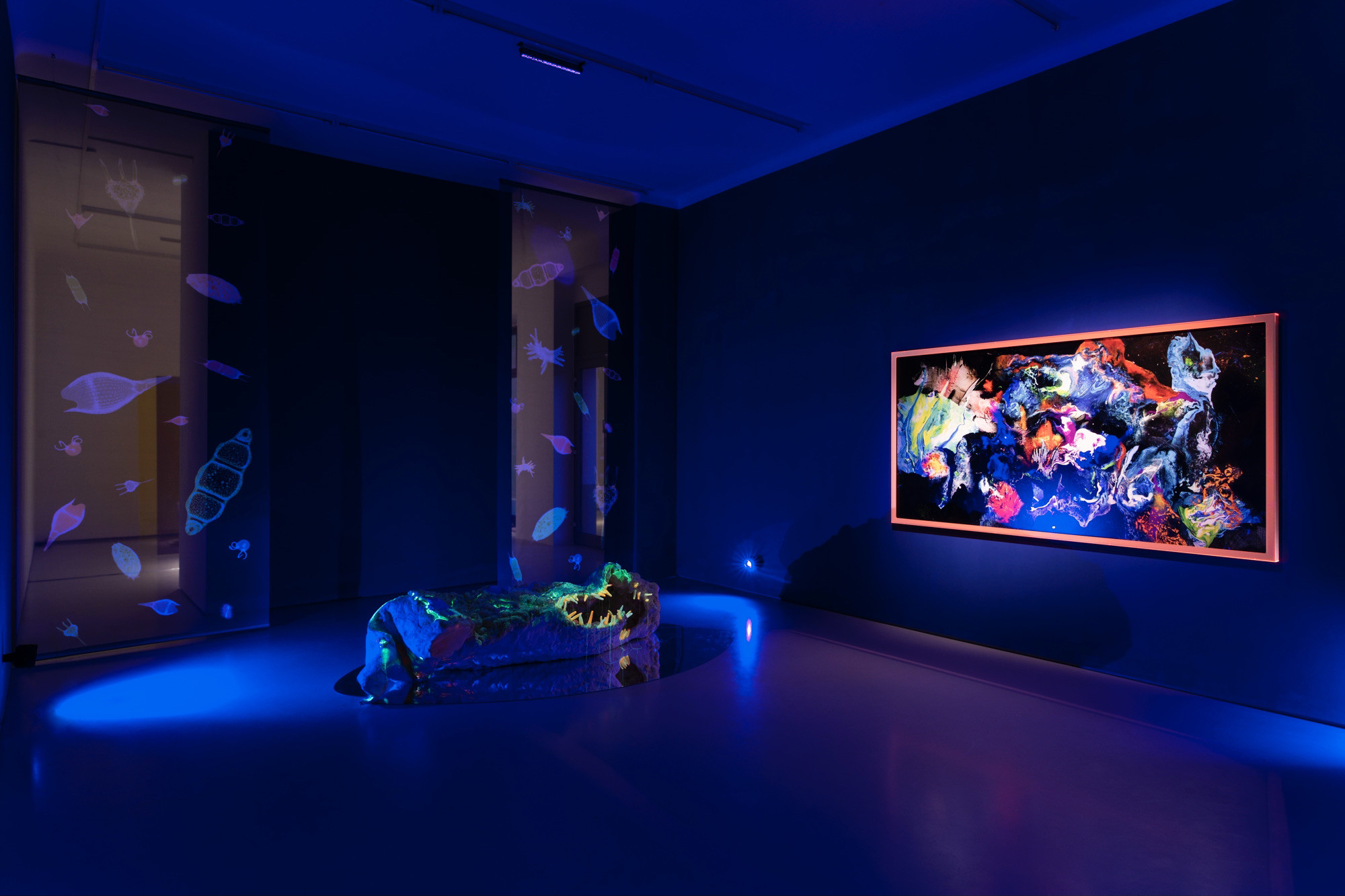
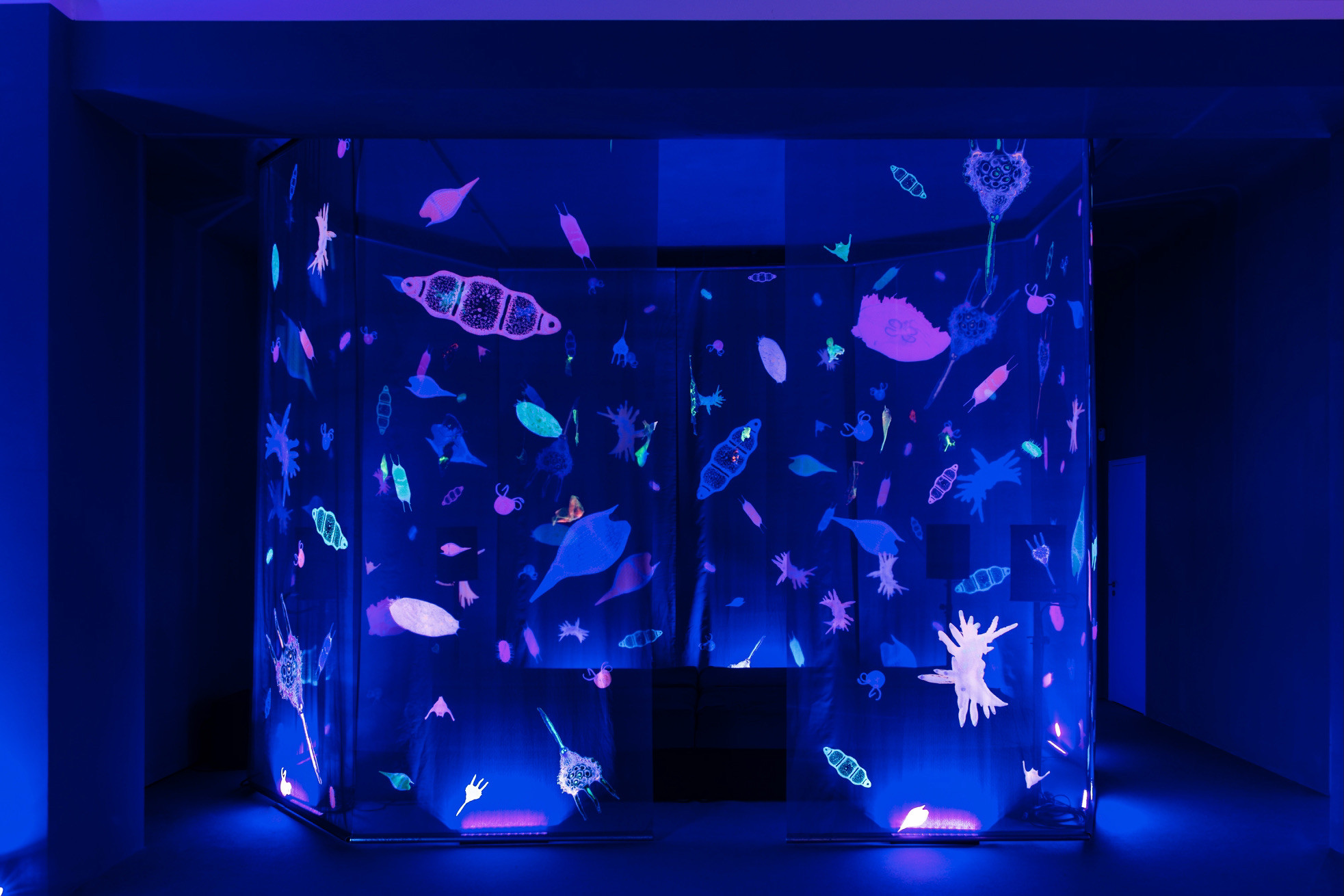
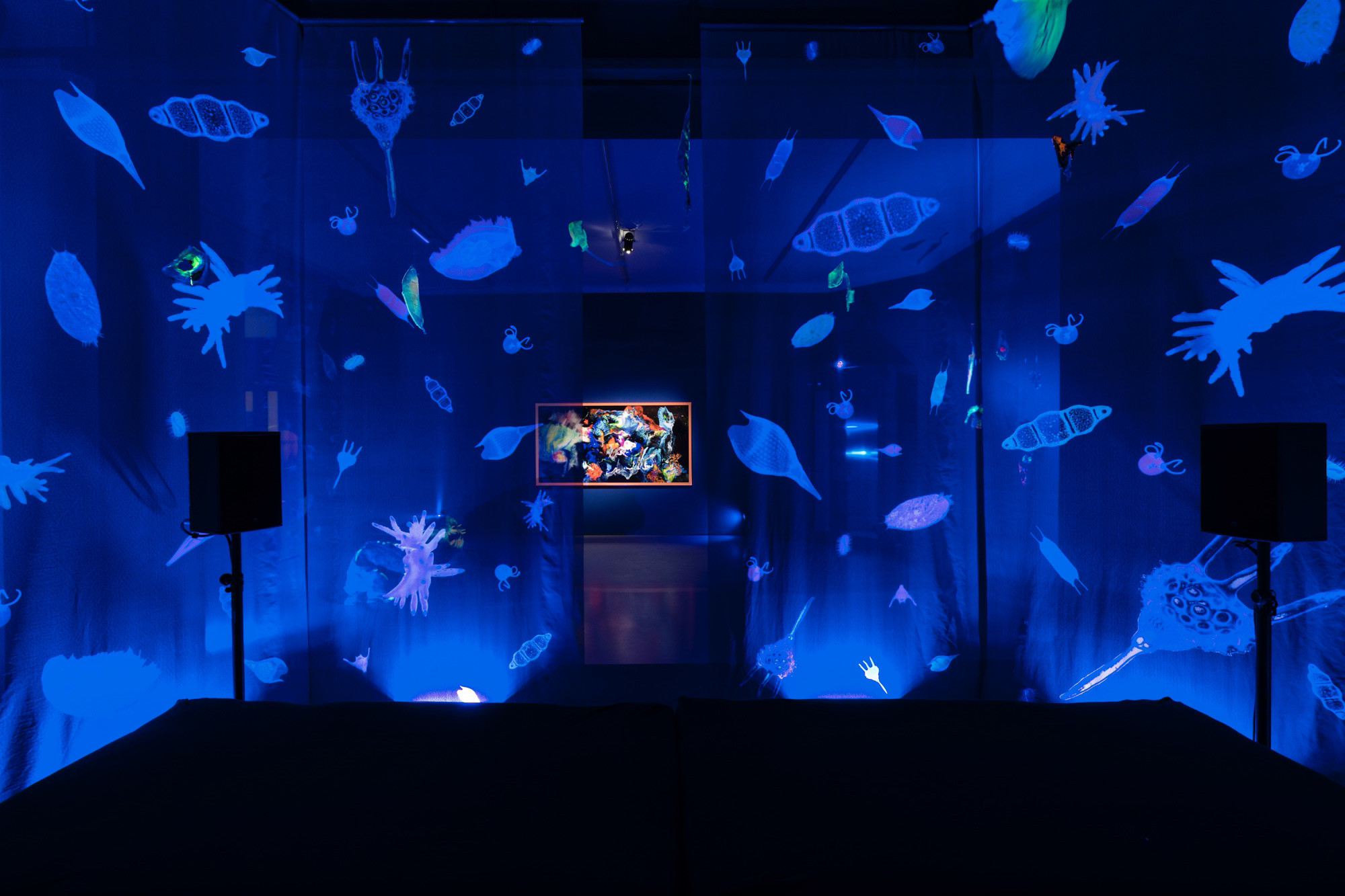
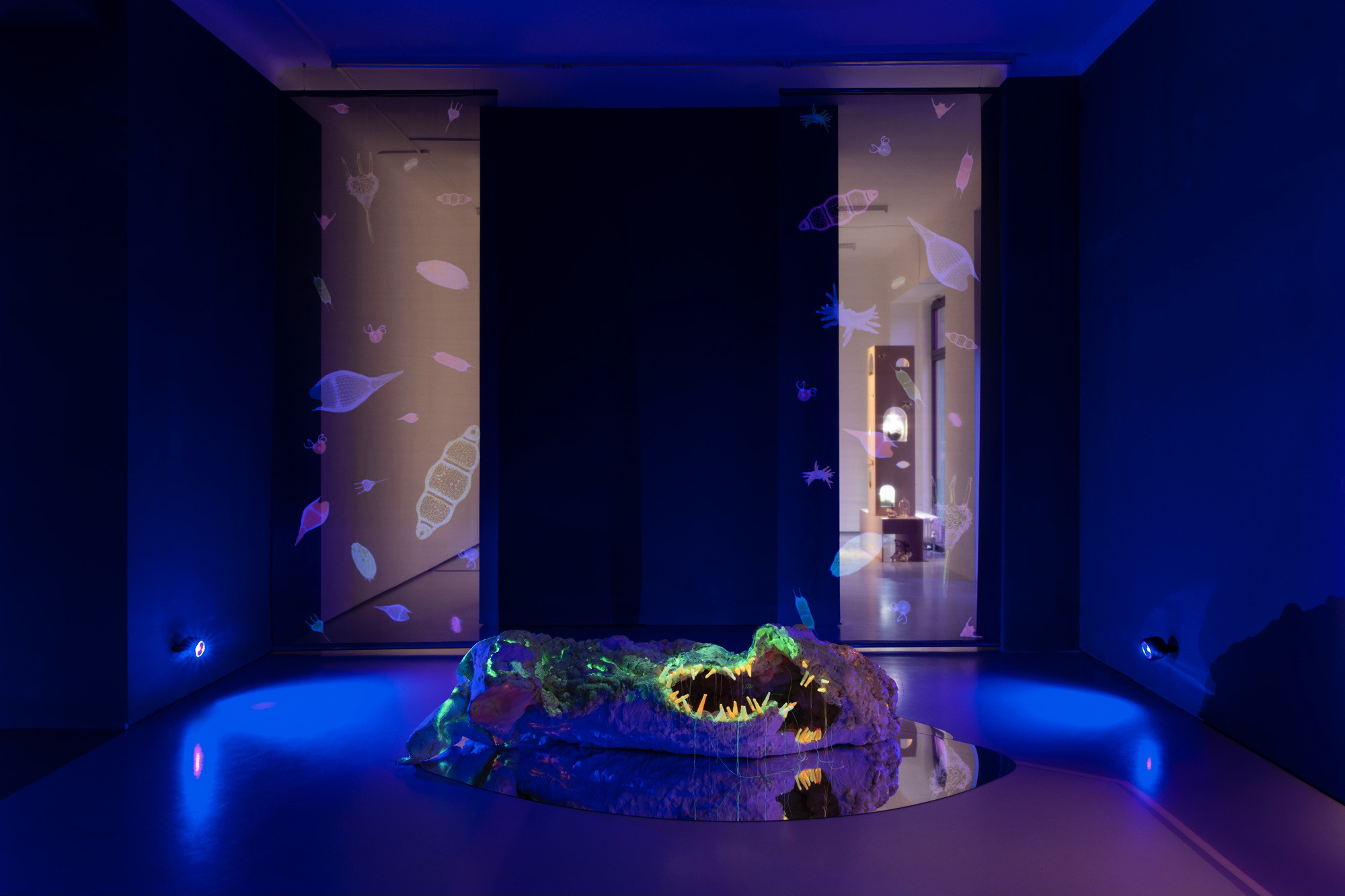
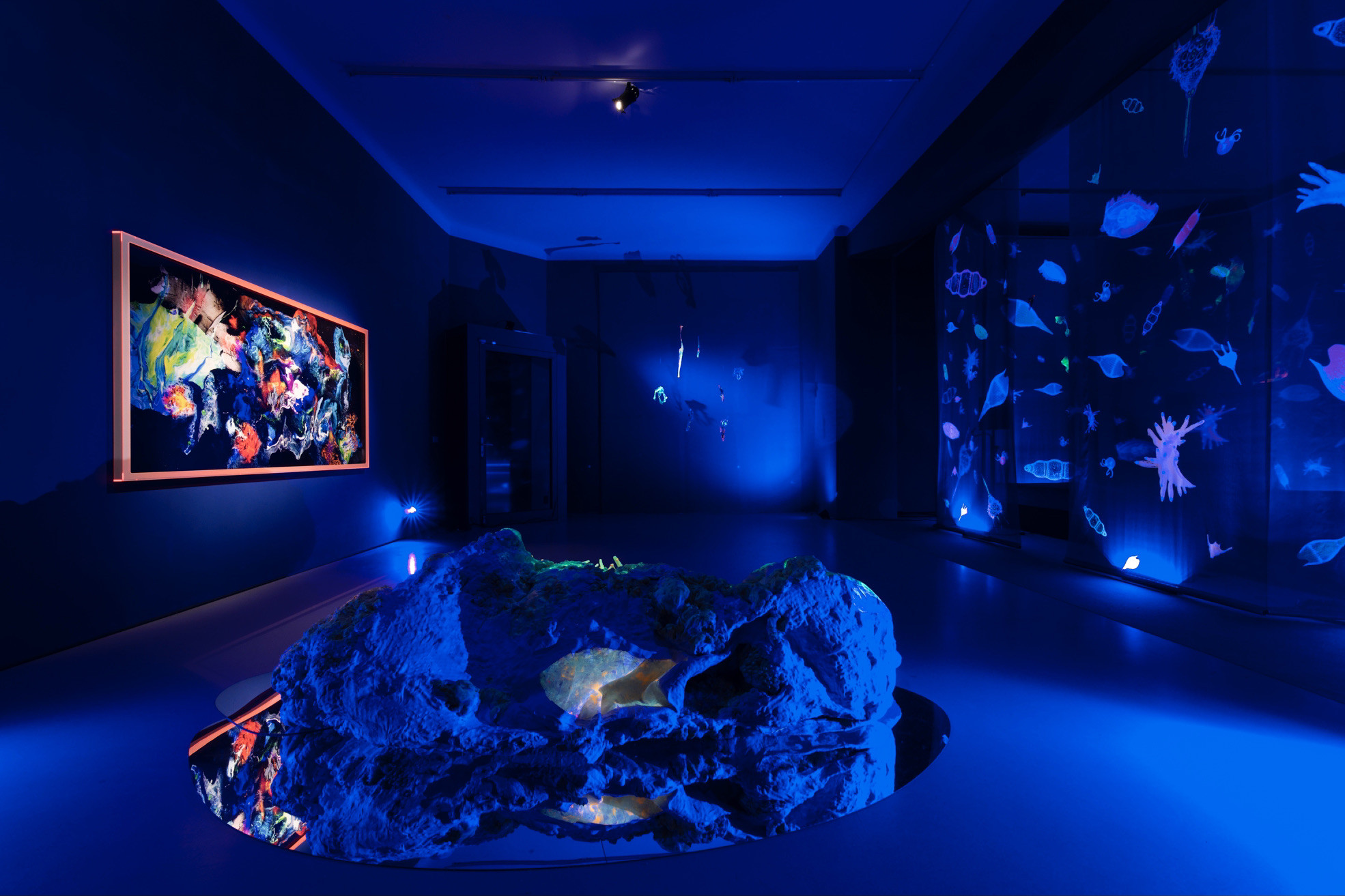
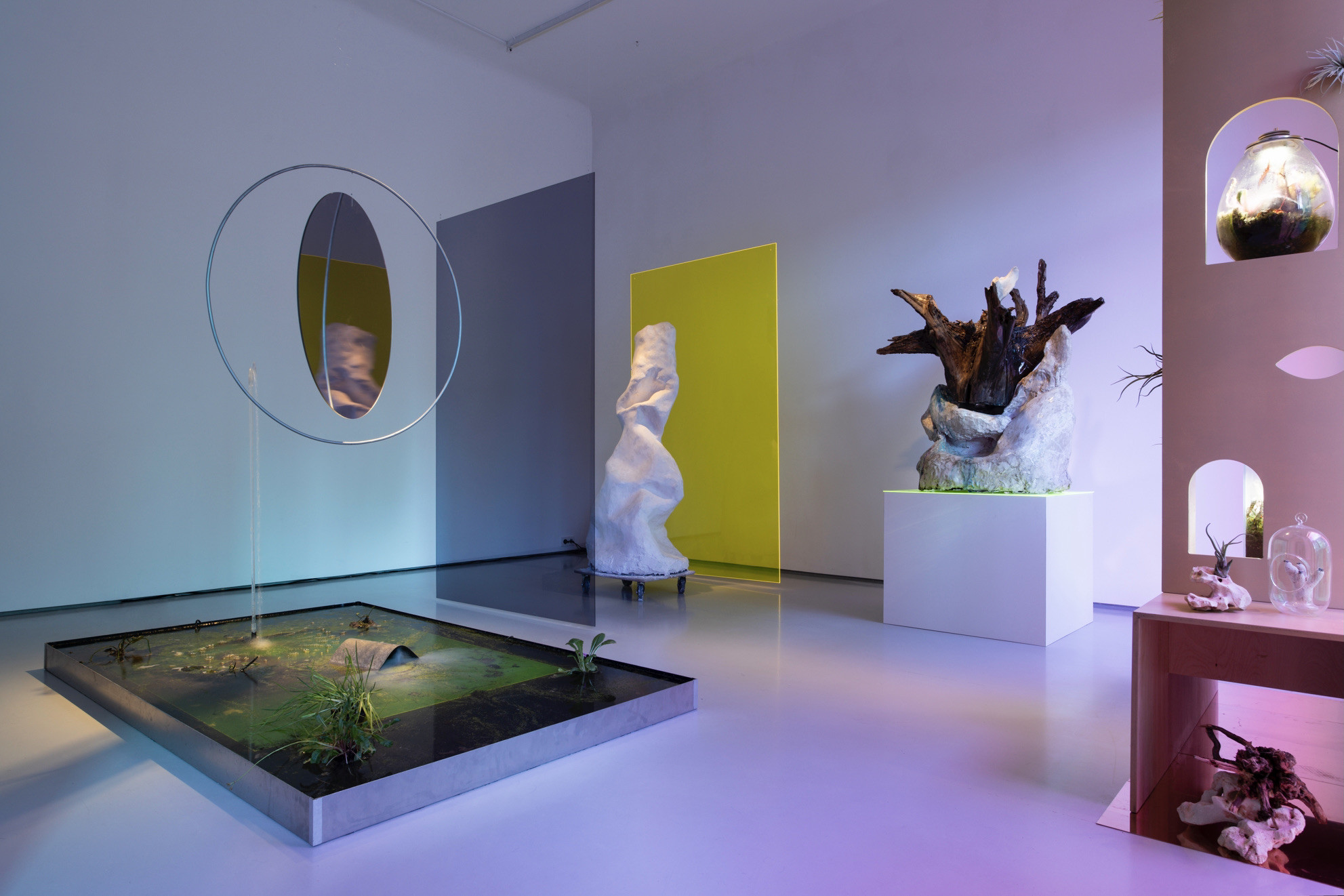
Anne Duk Hee Jordan’s work inhabits hybrid worlds both under and above water, composed of tiny critters which often don’t receive much attention in our dealings with the space we call nature. She attunes us to this place, which might be better thought of as processes of intimate co-becoming of human and nonhuman strangers in the sense of biologist Lynn Margulis. In the compound worlds Jordan conjures in her works, artificial-natural chimeras come to life, scales are distorted to center miniscule organisms as giant protagonists, and deep entanglements undo any idea of separation between culture and phantasmas of pure, untouched, pristine nature.
In a moment when humans’ disproportionate impact on nature is well known and felt, with those in the Global North more severely contributing to the ruinous effects than others, Jordan homes our senses in on specific ecosystems. Her multi-sensory installation Worlds Away (2022), lending the exhibition its title, plunges us into the ocean’s depths, into a dark world inhabited by, or rather composed of, fantastical creatures including a giant clam and microscopic phytoplankton. The silhouettes of these plant-like drifters are printed on translucent sheets of fabric in blues, purples, and greens—the color spectrum still visible to the human eye as we descend under water, where reds and yellows are first absorbed as light ceases to reach the ocean’s depths. Illuminated by black light, with phytoplankton sculptures also suspended from the ceiling and a mattress in the center of the space inviting visitors to lie down and shift their perspective—akin to divers looking up to the surface at refracting light—the installation is a psychedelic environment reminiscent of Hélio Oiticica’s immersive Cosmococa pavilions from the 1970s. Much like in the practice of the Tropicália art movement’s cofounder, Jordan’s installations accentuate proprioception, or one’s own sense of bodily presence and location in space. In fact, aside from being an artist, a diver, and a chef, she is also a trained therapist, specializing in kinaesthetics, or the study of body movements.
Underwater worlds feature in several of Jordan’s works, among them motorized clapping clam sculptures recalling the humor in Jean Tinguely’s kinetic constellations, or the video Ziggy and the Starfish (2016–18), which offers an erotic view—at least from a human perspective—of anemones, corals, sea cucumbers, and other creatures akin to Imogen Cunningham’s suggestive flower photographs. In Jordan’s Worlds Away, visitors’ sense of presence is further heightened by a soundtrack composed collaboratively with Filip Caranica from whale songs, breathing, and the disturbances of a motor boat. The low notes can be sensed more intensely when lying down on the mattress, while towards the end the loop rises to higher notes as if lifting us up to lower depths.
Continuing through the exhibition, Jordan transports us back from the deep sea to the surface to dwell in the aerial sphere. The ethereal installation Twilight (2022) consists in vertically hung transparent plexiglass sheets in yellow and grey hues; a round mirror turning slowly propelled by the air drift; a wooden structure inhabited by air plants who thrive on moisture sucked out of the air; terrariums hosting carnivorous plants, plastic flies, and a human jaw; and two large plaster sculptures: a wobbly organic-looking vertical shape on wheels, and an upside-down tree root conserved in, or rather swallowed by, a messy epoxy lump covered in paint sprinkles. A water basin with waterlilies is transformed over the course of the exhibition as algae and bacterial mats take over this human-created ecosystem. The installation is inspired by the modernist architecture of Mies van der Rohe and his 1929 Barcelona Pavilion. The building’s famous viewpoints emphasize permeability between inside and outside and give view onto a water basin, where the sculpture Der Morgen [Dawn] (1925) by Georg Kolbe was placed, in whose eponymous museum in Berlin Twilight was first exhibited. In Jordan’s installation, van der Rohe’s modernist masterpiece is turned into a contemporary ecosystem, in which the blurred principles between architecture’s inside and nature’s outside are converged to the point where these divides become indistinguishable altogether. Indeed, this liminality is emphasized by the work’s title dwelling in the in-betweenness of not only space but also time, marked by the soft glowing light as day passes into night and night into day with the perpetual rotation of the Earth.
Descending into the lower exhibition space, Jordan zooms in once again on the microscopic, however this time terrestrial. The video Brakfesten/La Grande Bouffe (2022), made in collaboration with curator and visual researcher Pauline Doutreluingne and edited by Judy Landkammer, was filmed over two years in the natural reservoir of Södra Hällarna on Gotland, Sweden, where elm trees are currently under threat from elm beetles. However, rather than presenting a simplistic view on nature and its destruction, the film focuses on the complex interdependencies between the trees and the beetles, who lay eggs in the bark which give life to larvae, who in turn form symbiotic relationships with fungi and attract insects, birds, and other animals in this cycle of decay and renewal. The title of the video references La Grande Bouffe, the 1973 cult film that satirizes consumerism through a plot in which a group of friends indulges in a night of debauchery intent on eating themselves to death. Brakfesten depicts a feast of larvae, caterpillars, insects, fungi, birds, and frogs in close-up camera takes and backed by their masticating sounds as part of a score by Midori Hirano, as they chew and reproduce, calling to mind excess à la Paul McCarthy but sans humans.
The close-up shots are layered with stop-motion cartoons animated by Moana Vonstadl and interspersed with footage of a sculptural installation Jordan and Doutreluingne built in the woods. Placing dead elm trees in a forest clearing in the shape of the burrowing patterns that the beetles form in the tree bark, equipped with small rivulets and bird towers, the installation is a public artwork for nonhuman visitors—a buffet offered in hopes of accelerating the regeneration of the forest. A locally researched edible landscape—this time for humans—also forms the basis of Jordan’s Into the Wild (2017–ongoing), a table planted with herbs and fragrance flowers. For each iteration of the project, Jordan organizes meals with plants grown on the dining sculpture, which participants eat directly with their hands, with food scraps left behind to turn into soil on the entirely compostable table.
In turning our perspectives topsy-turvy by centering gigantic microorganisms, turning modernist architecture into a biotope for nonhumans, or providing a buffet to beetles and edible tables to humans, Jordan sharpens our sense of self composed of multiple selves and attunes us to the symbiotic processes needed for worlding unknown futures.
Text by Stefanie Hessler